Lehman Brothers Collapse: Case Study of The Last Days & Analysis
VerifiedAdded on 2023/06/03
|5
|1130
|446
Case Study
AI Summary
This case study examines the events leading up to the collapse of Lehman Brothers in September 2008. It details the firm's deteriorating financial situation, including declining stock values, customer withdrawals, and increasing collateral demands from banks. The analysis covers key moments such a...
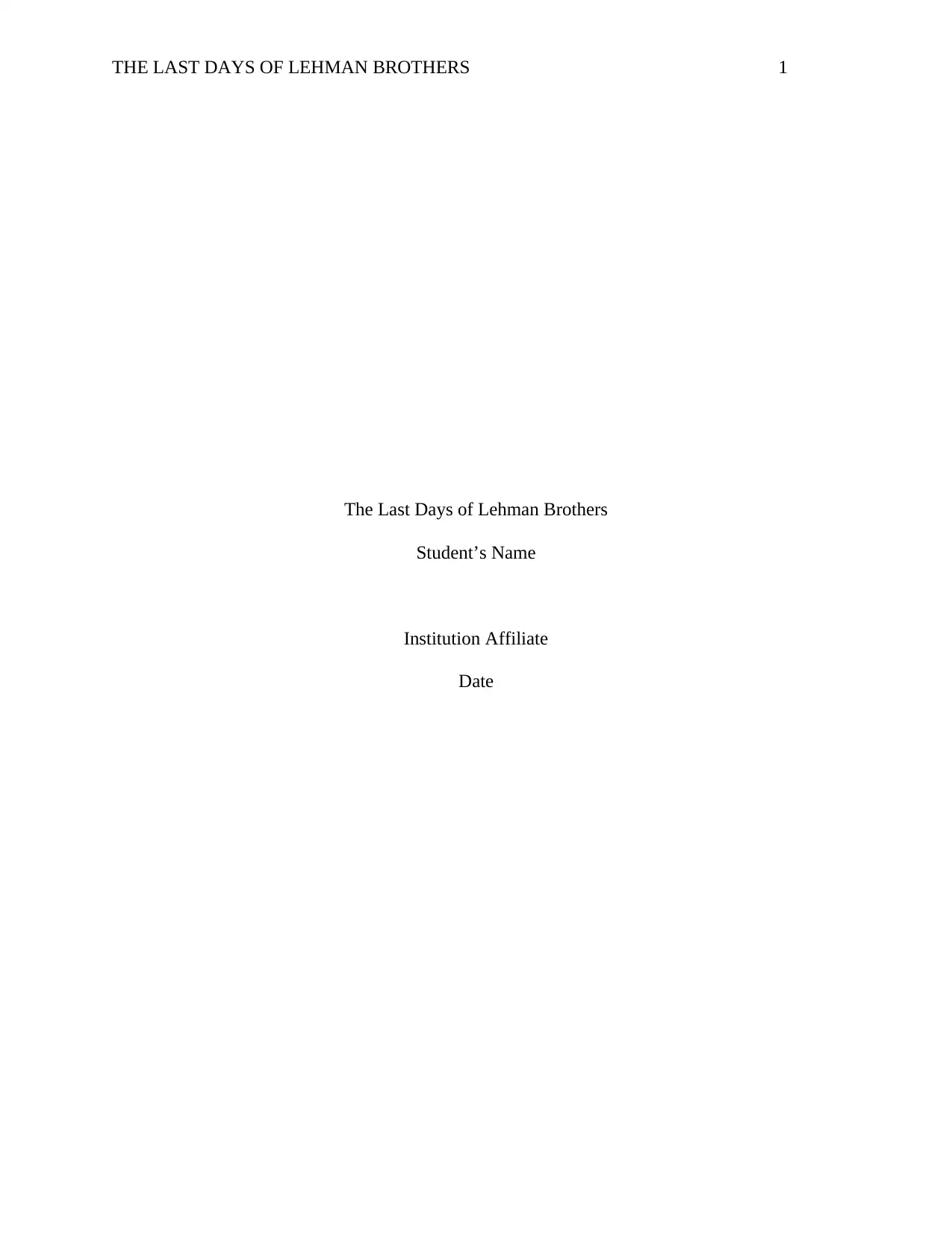
THE LAST DAYS OF LEHMAN BROTHERS 1
The Last Days of Lehman Brothers
Student’s Name
Institution Affiliate
Date
The Last Days of Lehman Brothers
Student’s Name
Institution Affiliate
Date
Paraphrase This Document
Need a fresh take? Get an instant paraphrase of this document with our AI Paraphraser
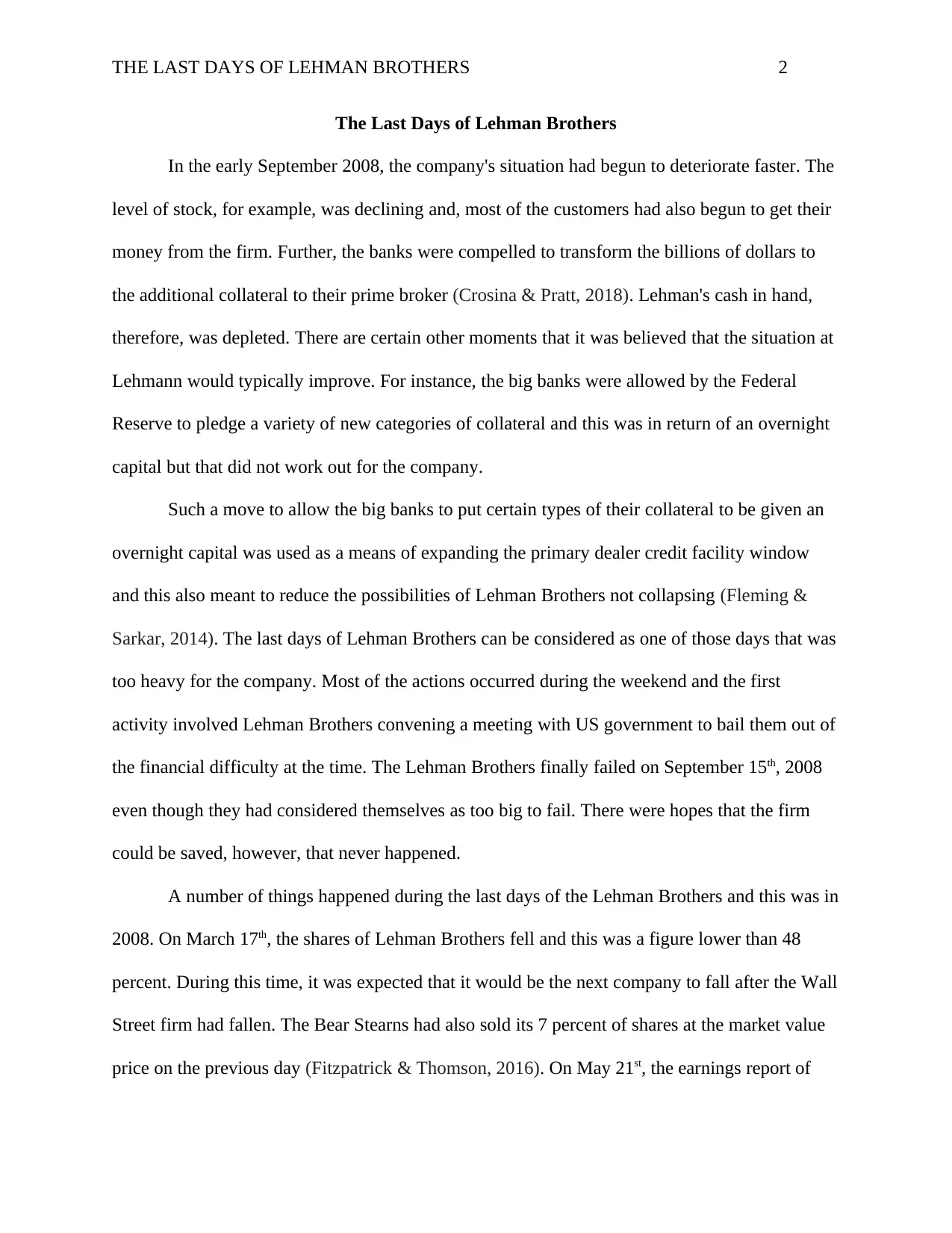
THE LAST DAYS OF LEHMAN BROTHERS 2
The Last Days of Lehman Brothers
In the early September 2008, the company's situation had begun to deteriorate faster. The
level of stock, for example, was declining and, most of the customers had also begun to get their
money from the firm. Further, the banks were compelled to transform the billions of dollars to
the additional collateral to their prime broker (Crosina & Pratt, 2018). Lehman's cash in hand,
therefore, was depleted. There are certain other moments that it was believed that the situation at
Lehmann would typically improve. For instance, the big banks were allowed by the Federal
Reserve to pledge a variety of new categories of collateral and this was in return of an overnight
capital but that did not work out for the company.
Such a move to allow the big banks to put certain types of their collateral to be given an
overnight capital was used as a means of expanding the primary dealer credit facility window
and this also meant to reduce the possibilities of Lehman Brothers not collapsing (Fleming &
Sarkar, 2014). The last days of Lehman Brothers can be considered as one of those days that was
too heavy for the company. Most of the actions occurred during the weekend and the first
activity involved Lehman Brothers convening a meeting with US government to bail them out of
the financial difficulty at the time. The Lehman Brothers finally failed on September 15th, 2008
even though they had considered themselves as too big to fail. There were hopes that the firm
could be saved, however, that never happened.
A number of things happened during the last days of the Lehman Brothers and this was in
2008. On March 17th, the shares of Lehman Brothers fell and this was a figure lower than 48
percent. During this time, it was expected that it would be the next company to fall after the Wall
Street firm had fallen. The Bear Stearns had also sold its 7 percent of shares at the market value
price on the previous day (Fitzpatrick & Thomson, 2016). On May 21st, the earnings report of
The Last Days of Lehman Brothers
In the early September 2008, the company's situation had begun to deteriorate faster. The
level of stock, for example, was declining and, most of the customers had also begun to get their
money from the firm. Further, the banks were compelled to transform the billions of dollars to
the additional collateral to their prime broker (Crosina & Pratt, 2018). Lehman's cash in hand,
therefore, was depleted. There are certain other moments that it was believed that the situation at
Lehmann would typically improve. For instance, the big banks were allowed by the Federal
Reserve to pledge a variety of new categories of collateral and this was in return of an overnight
capital but that did not work out for the company.
Such a move to allow the big banks to put certain types of their collateral to be given an
overnight capital was used as a means of expanding the primary dealer credit facility window
and this also meant to reduce the possibilities of Lehman Brothers not collapsing (Fleming &
Sarkar, 2014). The last days of Lehman Brothers can be considered as one of those days that was
too heavy for the company. Most of the actions occurred during the weekend and the first
activity involved Lehman Brothers convening a meeting with US government to bail them out of
the financial difficulty at the time. The Lehman Brothers finally failed on September 15th, 2008
even though they had considered themselves as too big to fail. There were hopes that the firm
could be saved, however, that never happened.
A number of things happened during the last days of the Lehman Brothers and this was in
2008. On March 17th, the shares of Lehman Brothers fell and this was a figure lower than 48
percent. During this time, it was expected that it would be the next company to fall after the Wall
Street firm had fallen. The Bear Stearns had also sold its 7 percent of shares at the market value
price on the previous day (Fitzpatrick & Thomson, 2016). On May 21st, the earnings report of
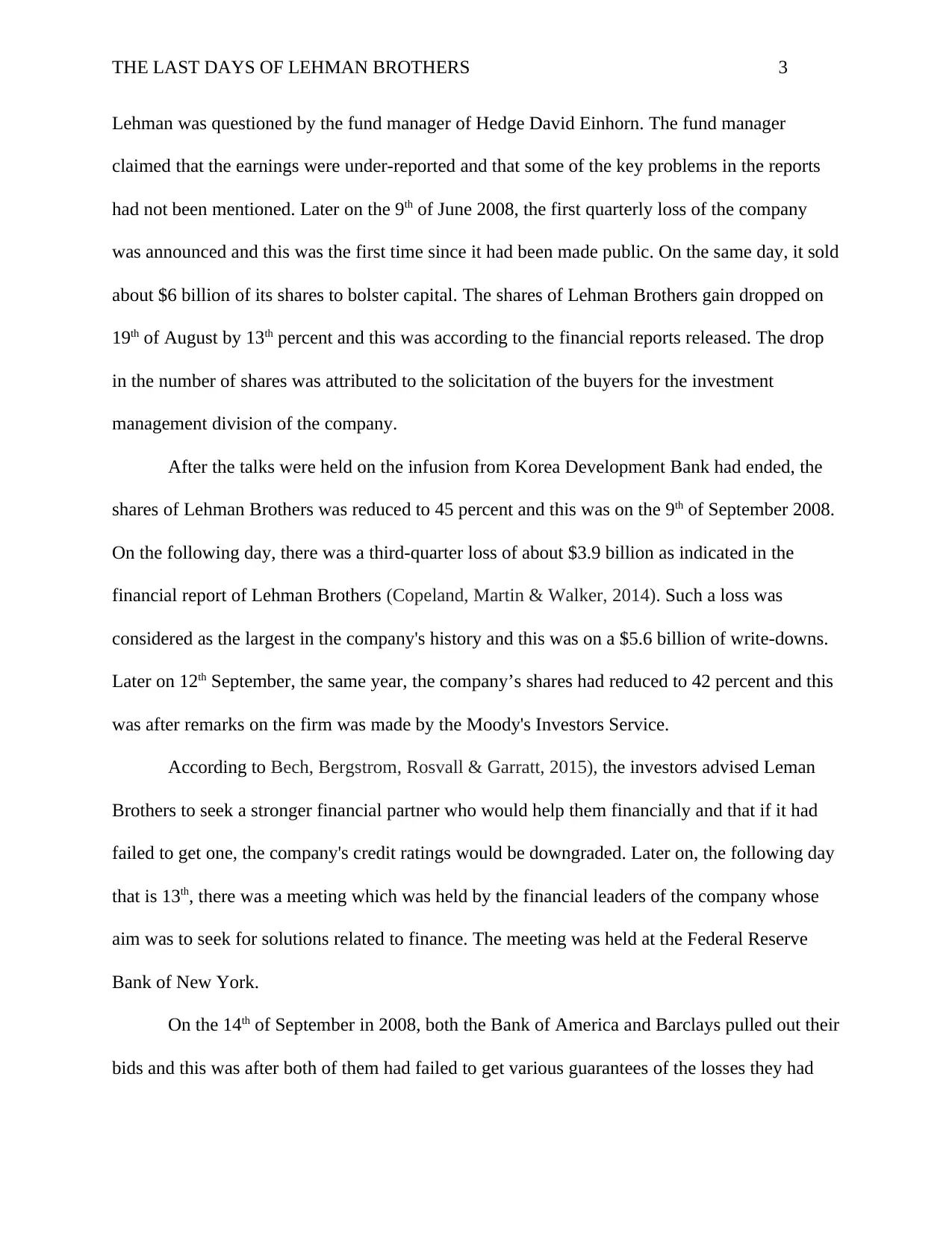
THE LAST DAYS OF LEHMAN BROTHERS 3
Lehman was questioned by the fund manager of Hedge David Einhorn. The fund manager
claimed that the earnings were under-reported and that some of the key problems in the reports
had not been mentioned. Later on the 9th of June 2008, the first quarterly loss of the company
was announced and this was the first time since it had been made public. On the same day, it sold
about $6 billion of its shares to bolster capital. The shares of Lehman Brothers gain dropped on
19th of August by 13th percent and this was according to the financial reports released. The drop
in the number of shares was attributed to the solicitation of the buyers for the investment
management division of the company.
After the talks were held on the infusion from Korea Development Bank had ended, the
shares of Lehman Brothers was reduced to 45 percent and this was on the 9th of September 2008.
On the following day, there was a third-quarter loss of about $3.9 billion as indicated in the
financial report of Lehman Brothers (Copeland, Martin & Walker, 2014). Such a loss was
considered as the largest in the company's history and this was on a $5.6 billion of write-downs.
Later on 12th September, the same year, the company’s shares had reduced to 42 percent and this
was after remarks on the firm was made by the Moody's Investors Service.
According to Bech, Bergstrom, Rosvall & Garratt, 2015), the investors advised Leman
Brothers to seek a stronger financial partner who would help them financially and that if it had
failed to get one, the company's credit ratings would be downgraded. Later on, the following day
that is 13th, there was a meeting which was held by the financial leaders of the company whose
aim was to seek for solutions related to finance. The meeting was held at the Federal Reserve
Bank of New York.
On the 14th of September in 2008, both the Bank of America and Barclays pulled out their
bids and this was after both of them had failed to get various guarantees of the losses they had
Lehman was questioned by the fund manager of Hedge David Einhorn. The fund manager
claimed that the earnings were under-reported and that some of the key problems in the reports
had not been mentioned. Later on the 9th of June 2008, the first quarterly loss of the company
was announced and this was the first time since it had been made public. On the same day, it sold
about $6 billion of its shares to bolster capital. The shares of Lehman Brothers gain dropped on
19th of August by 13th percent and this was according to the financial reports released. The drop
in the number of shares was attributed to the solicitation of the buyers for the investment
management division of the company.
After the talks were held on the infusion from Korea Development Bank had ended, the
shares of Lehman Brothers was reduced to 45 percent and this was on the 9th of September 2008.
On the following day, there was a third-quarter loss of about $3.9 billion as indicated in the
financial report of Lehman Brothers (Copeland, Martin & Walker, 2014). Such a loss was
considered as the largest in the company's history and this was on a $5.6 billion of write-downs.
Later on 12th September, the same year, the company’s shares had reduced to 42 percent and this
was after remarks on the firm was made by the Moody's Investors Service.
According to Bech, Bergstrom, Rosvall & Garratt, 2015), the investors advised Leman
Brothers to seek a stronger financial partner who would help them financially and that if it had
failed to get one, the company's credit ratings would be downgraded. Later on, the following day
that is 13th, there was a meeting which was held by the financial leaders of the company whose
aim was to seek for solutions related to finance. The meeting was held at the Federal Reserve
Bank of New York.
On the 14th of September in 2008, both the Bank of America and Barclays pulled out their
bids and this was after both of them had failed to get various guarantees of the losses they had
⊘ This is a preview!⊘
Do you want full access?
Subscribe today to unlock all pages.

Trusted by 1+ million students worldwide
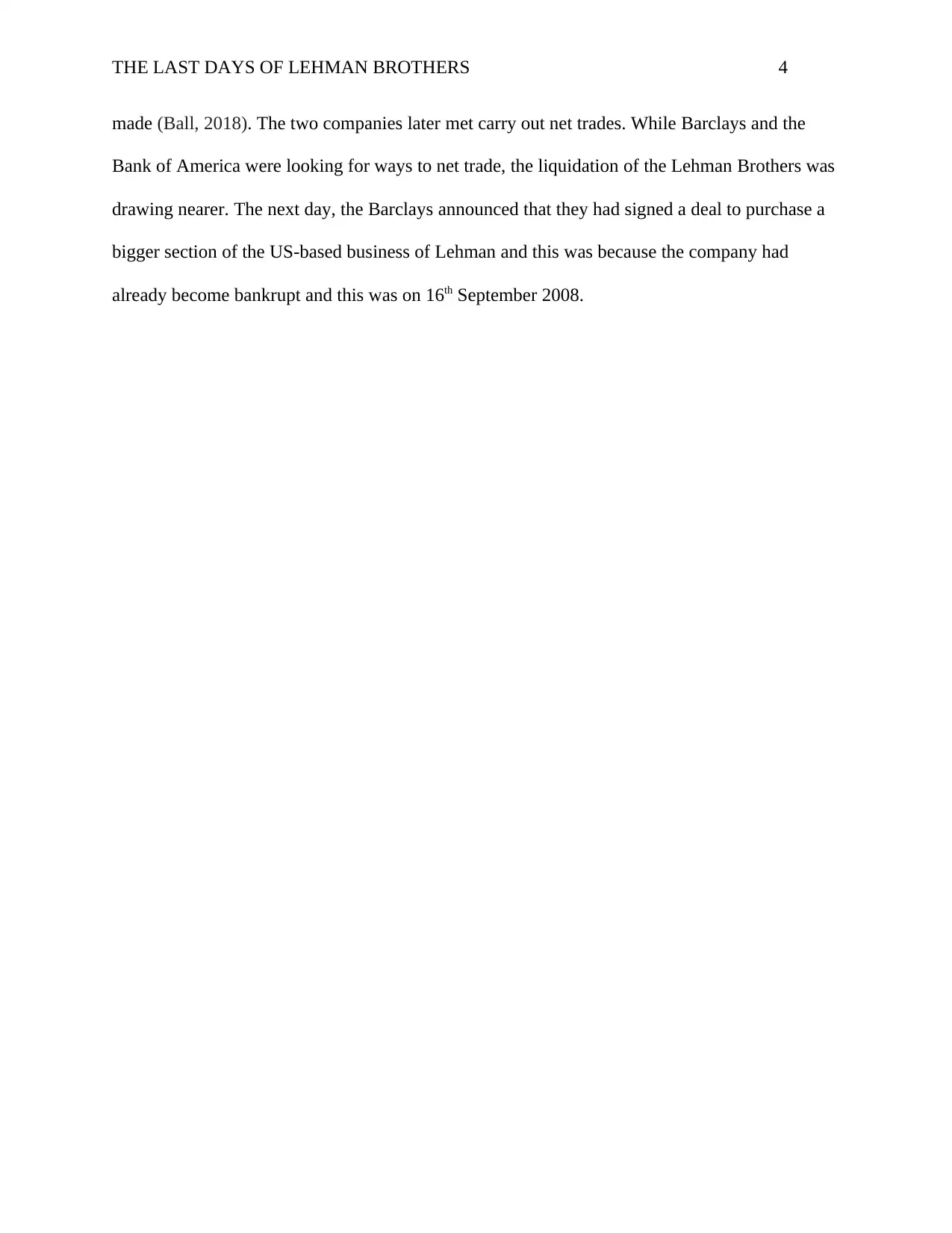
THE LAST DAYS OF LEHMAN BROTHERS 4
made (Ball, 2018). The two companies later met carry out net trades. While Barclays and the
Bank of America were looking for ways to net trade, the liquidation of the Lehman Brothers was
drawing nearer. The next day, the Barclays announced that they had signed a deal to purchase a
bigger section of the US-based business of Lehman and this was because the company had
already become bankrupt and this was on 16th September 2008.
made (Ball, 2018). The two companies later met carry out net trades. While Barclays and the
Bank of America were looking for ways to net trade, the liquidation of the Lehman Brothers was
drawing nearer. The next day, the Barclays announced that they had signed a deal to purchase a
bigger section of the US-based business of Lehman and this was because the company had
already become bankrupt and this was on 16th September 2008.
Paraphrase This Document
Need a fresh take? Get an instant paraphrase of this document with our AI Paraphraser
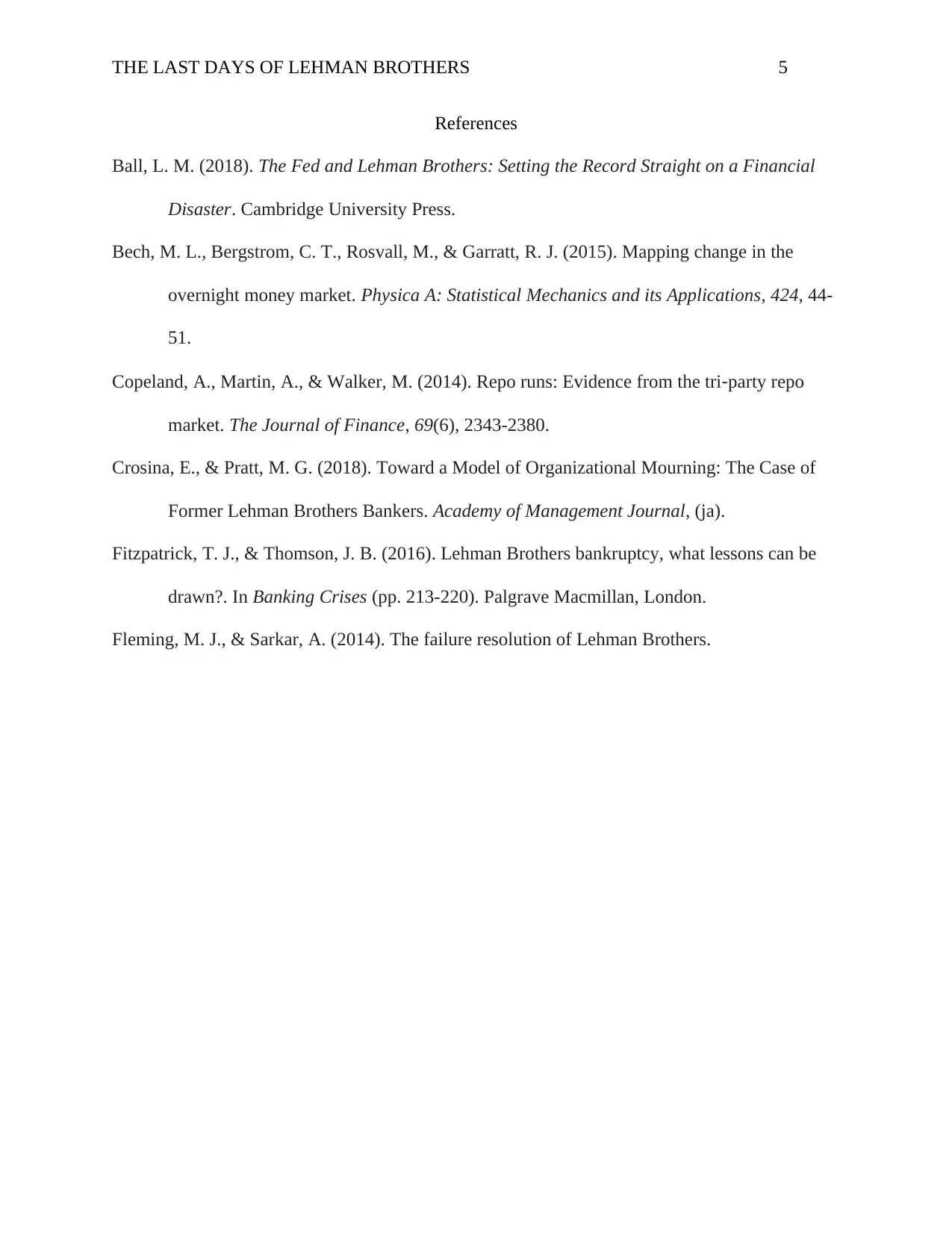
THE LAST DAYS OF LEHMAN BROTHERS 5
References
Ball, L. M. (2018). The Fed and Lehman Brothers: Setting the Record Straight on a Financial
Disaster. Cambridge University Press.
Bech, M. L., Bergstrom, C. T., Rosvall, M., & Garratt, R. J. (2015). Mapping change in the
overnight money market. Physica A: Statistical Mechanics and its Applications, 424, 44-
51.
Copeland, A., Martin, A., & Walker, M. (2014). Repo runs: Evidence from the tri‐party repo
market. The Journal of Finance, 69(6), 2343-2380.
Crosina, E., & Pratt, M. G. (2018). Toward a Model of Organizational Mourning: The Case of
Former Lehman Brothers Bankers. Academy of Management Journal, (ja).
Fitzpatrick, T. J., & Thomson, J. B. (2016). Lehman Brothers bankruptcy, what lessons can be
drawn?. In Banking Crises (pp. 213-220). Palgrave Macmillan, London.
Fleming, M. J., & Sarkar, A. (2014). The failure resolution of Lehman Brothers.
References
Ball, L. M. (2018). The Fed and Lehman Brothers: Setting the Record Straight on a Financial
Disaster. Cambridge University Press.
Bech, M. L., Bergstrom, C. T., Rosvall, M., & Garratt, R. J. (2015). Mapping change in the
overnight money market. Physica A: Statistical Mechanics and its Applications, 424, 44-
51.
Copeland, A., Martin, A., & Walker, M. (2014). Repo runs: Evidence from the tri‐party repo
market. The Journal of Finance, 69(6), 2343-2380.
Crosina, E., & Pratt, M. G. (2018). Toward a Model of Organizational Mourning: The Case of
Former Lehman Brothers Bankers. Academy of Management Journal, (ja).
Fitzpatrick, T. J., & Thomson, J. B. (2016). Lehman Brothers bankruptcy, what lessons can be
drawn?. In Banking Crises (pp. 213-220). Palgrave Macmillan, London.
Fleming, M. J., & Sarkar, A. (2014). The failure resolution of Lehman Brothers.
1 out of 5
Related Documents
Your All-in-One AI-Powered Toolkit for Academic Success.
+13062052269
info@desklib.com
Available 24*7 on WhatsApp / Email
![[object Object]](/_next/static/media/star-bottom.7253800d.svg)
Unlock your academic potential
© 2024 | Zucol Services PVT LTD | All rights reserved.





